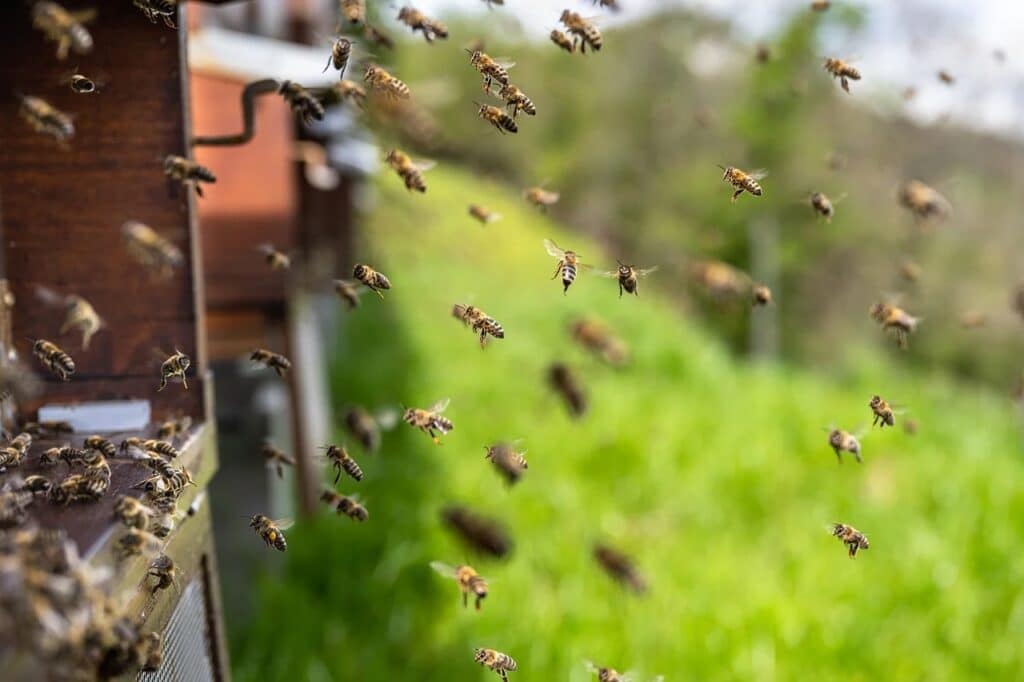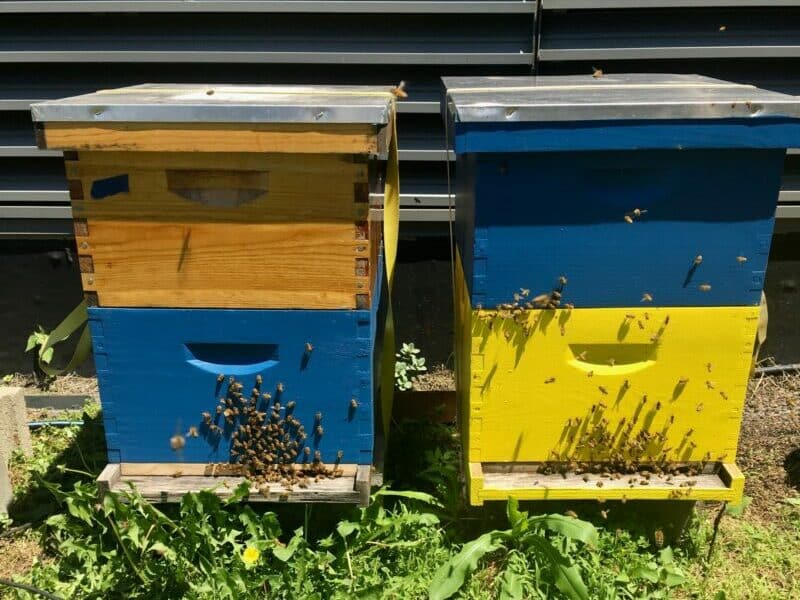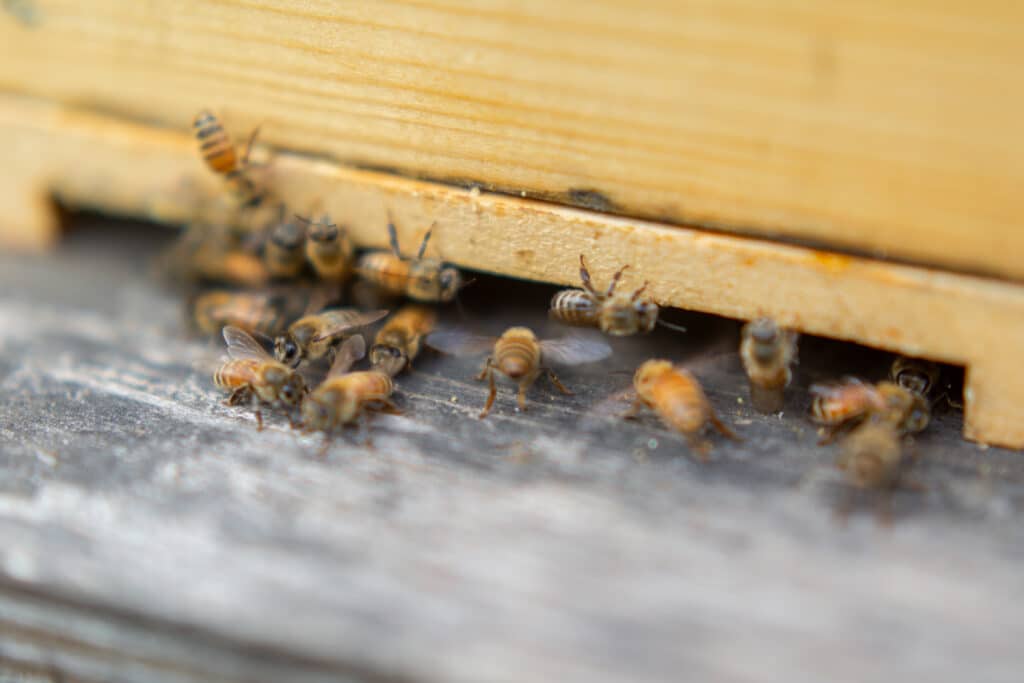Contents:
- What are robber bees?
- What is bee robbing?
- When does bee robbing occur?
- Why does bee robbing happen, and what can lead to this?
- What does bee robbing look like?
- How to prevent bee robbing
- What to do if bee robbing is occurring at your hive
- FAQs
What are robber bees?
Despite their specific nickname, robber bees are not a subspecies of bee (like a leafcutter bee or a mason bee). Robber bees are regular honeybees that invade another colony’s hive, typically because their own resources, such as honey and nectar, are lacking. Collecting honey and nectar is essential for the health of the colony, and honeybees will look for these resources wherever they can — including other hives nearby, if necessary. Robber bees aren’t trying to destroy another colony, but rather save their own from starvation.
What is bee robbing?

Bee robbing is known as the act of a colony being invaded by other bees, primarily for honey. Typically, these robber bees are experiencing a lack of resources and are searching for weakened colonies that they can steal honey from. While a strong hive might be able to defend itself against robbers, colonies that are inferior often have difficulty protecting their own resources and are subject to the entire colony being overpowered by robbers from neighboring colonies.
There are various ways to identify robbing behavior within a hive, and it is crucial that a solution be implemented to help the original colony survive this invasion.
When does bee robbing occur?
According to HoneyBeeSuite.com, bee robbing can happen at any time, but it’s common to see this type of behavior occur in late summer to early fall, and especially during a nectar dearth. A nectar dearth is a period of time when there is a shortage of nectar-producing flowers–when there is a lower amount of nectar available to bees, they will become desperate to find alternative ways to locate this sugary fluid that is released by plants and turned into honey.
Why does bee robbing happen, and what can lead to this?
Although bee robbing is commonly associated with nectar dearth, there are other factors that, when happening all at once, can lead to this frantic behavior. BeeInformed.org notes that these conditions include nectar dearth, but also “large colony populations with a high proportion of foragers, temperatures suitable for intense flight activity, and potential for some colonies to dwindle due to progression of Varroa or other stressors.”
Since robber bees are searching for honey, they will begin to visit nearby colonies and will attempt to access the inside of the hive where this resource is stored. Often, beehives will have “guards” outside of the hive on the landing board that are present to detect and ward off any unwanted visitors, but if the hive being invaded is weaker, the easier it will be for the robbers to enter. Hives that are queenless are especially weakened as they do not have any means of reproduction or protection. Once these robbers enter the hive and confirm that honey is available, they will go back to the original colony to alert the rest of the bees–and will return together in order to invade the hive and drain the weaker colony of its resources.
There have also been voices within the pollinator community that raised concerns about urban beekeeping and “colony crowding” being a factor that can lead to increased robbing, diminished honey stocks, and an overall weakening of colonies. However, during The Best Bees Company’s 10+ years of closely studying the health and behavior of honeybees, we have found that at the current density, honeybees are not correlated to colony crowding, and the additional research conducted by the scientific community also confirms that the evidence of pollinator competition is inconclusive.
What does bee robbing look like?

Bee robbing is unique behavior, and is not to be confused with normal colony activity. Beehives are operating as normal when the activity at the hive entrance is calm, and bees are contently moving in and out of the hive with pollen and nectar.
When robbing is taking place, the behavior around and at the front of the hive becomes much more frantic. Robber bees can be identified by their desperate attempts at gaining access to the hive, leading to confusion among the original colony. From there, the original colony will try to defend their hive from this invasion, while the robber bees continue to try their best to enter the hive, including searching for alternative entrances at the top or on the sides of the boxes. As the robber bees fight the defending bees, both parties will lose hair, resulting in a shiny appearance. Fighting bees may tumble and roll in the air and on the hive; dead bees may be seen on the ground in front of the hive.
If the robber bees get inside the hive, they will begin to empty the frames of honey by ripping open the caps in each cell. As robber bees leave the hive, laden down with honey, they often crawl up the side to gain some elevation before they fly away and then dip towards the ground once they take off. This is harder to identify, but is another signal that a robbing is taking place. Once the robber bees have invaded the interior, the colony is weakened even further and the chances of this hive surviving without help decrease dramatically.
How to prevent bee robbing
Preventative measures are the key to protecting your colony against robbing; these measures include adjusted beekeeping practices and security add-ons to the hive. During the hotter months, when robbing is more likely to occur, beekeepers would be well advised to limit the amount of time the hive is open by keeping checks short and simple. Robbing bees are drawn to the smell of honey; keeping the hive open allows for the scent to spread.
On that note, beekeepers should be extra careful to not spill any honey on the ground. Not only does it attract the hungry robber bees, it also points them directly to the productive, honey-rich hive. If honey is spilled, it should be cleaned or covered up with water, dirt, or grass. If robber bees do try to rob a hive, they will try to enter through any means possible. Keeping a careful eye out for any cracks or holes in a hive, and repairing them if spotted, is another important beekeeping practice to prevent a colony from being robbed.
Beekeeping practices aside, another effective method of protecting against robbing is utilizing security add-ons: entrance reducers and robber/robbing screens. At The Best Bees Company, our beekeepers install entrance reducers in all our hives.
Entrance reducers live up to their name; they are wood, plastic, or metal pieces that fit into the entrance of the hive and limit the amount of space hostile outsiders can use to access the interior. Reducing the entrance makes it easier for the bees of the colony to defend their hive from intruders — a smaller space means fewer attackers for the bees to fend off at once.
Once the hotter months come around, we take off the entrance reducer and replace it with a robbing screen. Also known as a robber screen, this is another kind of entrance reducer, but made with mesh and netting to allow for increased ventilation during the summer.
What to do if robbing is occurring at your hive
When you see signs of bee robbing, taking swift action is the most important next step. According to BackyardHive.com, “the time it takes for the hive to collapse once robbing starts is a very short time span, usually in a day or two the hive is unrecoverable.” That’s why taking action is so crucial!
The bees being robbed will have put out alarm pheromones, so be prepared for defensiveness. Smoking the hive will provide a brief deterrent to the robber bees, at which point beekeepers need to attempt to block off entrances to the hive. Methods for this include:
- Throwing an old bedsheet or towel over the hive
- Leaning a wide board, plank, or sheet of plastic up against the front of the hive
- Stuffing grass into the entrance of the hive
In order to help a robbed hive after the event, beekeepers will often pull in resources like brood frames and nurse bees from neighboring hives. At The Best Bees Company, apiaries are an invaluable element of our beekeeping practice, as we are able to tap into stronger colonies and give excess resources to colonies in need. To learn more about why apiaries are an important part of managing and protecting beehives, read our conversation with Best Bees Apiary Manager Jordan Walker.
Above all, bee robbing can be a detrimental blow to any beehive — and beekeepers often learn of a robbing when it is too late! However, by implementing simple solutions as quickly as possible, like blocking the entrance to your hive and helping the colony get back to reproducing and creating their own resources, you will be able to increase the chances of a positive outcome for your bees. When in doubt, contact your local beekeeping organization, or get in touch with experts at The Best Bees Company for additional information and assistance.
FAQs
Q: What is bee robbing?
A: Bee robbing is a behavior of bees that are invading another hive for resources like honey when they do not have enough of their own.
Q: When does bee robbing happen?
A: Bee robbing can technically happen at any time, but it is most common in late summer or early fall when there is a shortage of nectar-producing flowers.
Q: What does bee robbing look like?
A; Bee robbing will often look like a frenzy happening outside of a hive, with robber bees attempting to gain access to the hive and its resources. You might even see small fights break out between the original colony and the bees invading, as well as the robber bees desperately trying to fly into the hive via the entrance, sides, and top of the boxes.
Q: What should I do if I see bee robbing?
A; First, take action quickly. Simple solutions like adding an entrance reducer made of plastic, wood, or metal can help limit the invasion of robber bees. However, this is not always effective, and additional measures like a robbing screen might be necessary.






